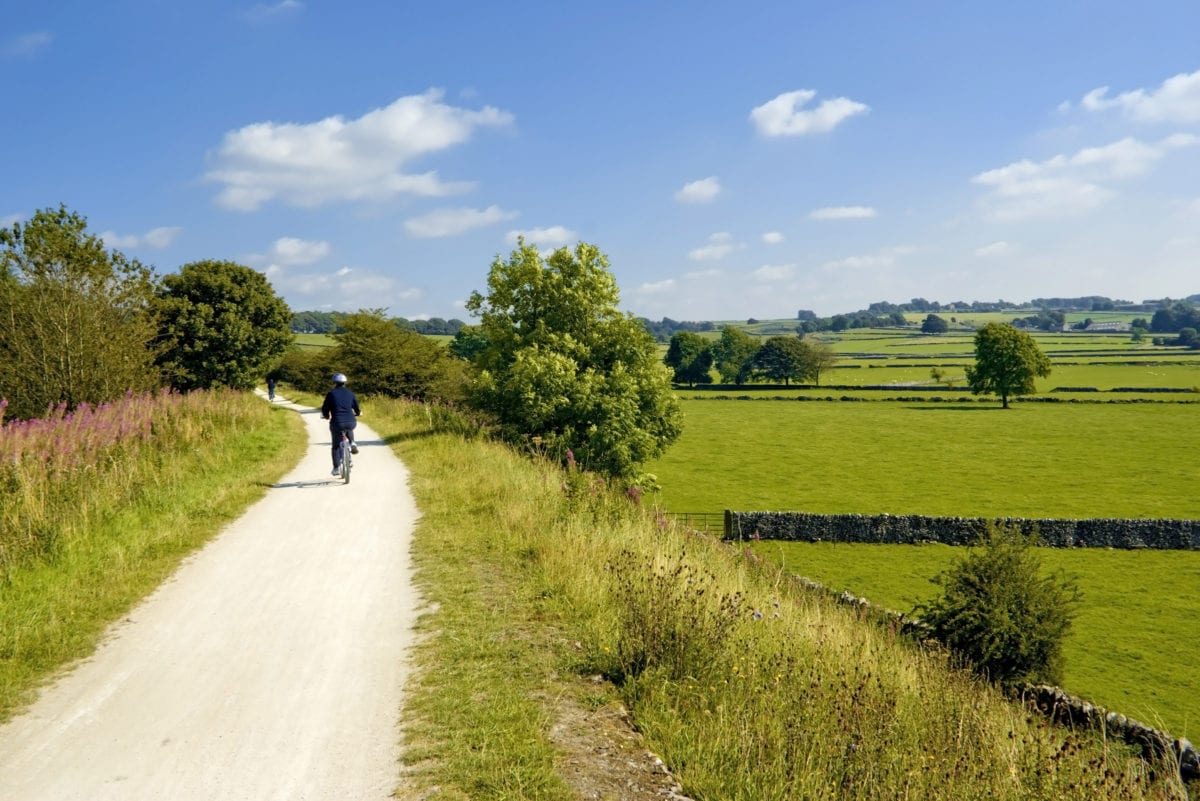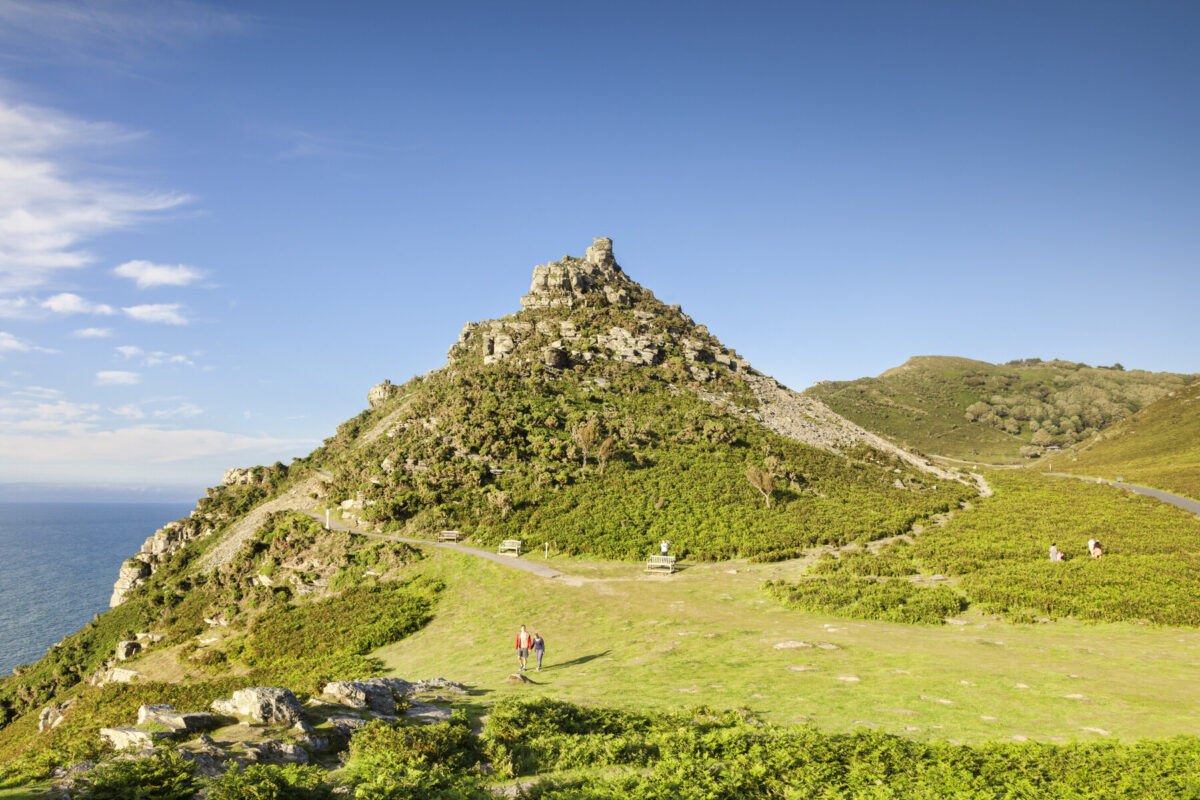In a small area it seemed to contain everything I liked best about rural England: dramatic coastal scenery, lovely villages advertising cream teas, little churches full of ancient village art – and Exmoor ponies.
Hilary Bradt, author of Slow Travel Exmoor
‘We came to the great River Exe … which rises in the hills on this north side of the county … The country it rises in is called Exmoor. Camden calls it a filthy barren ground, and indeed, so it is; but as soon as the Exe comes off from the moors and hilly country and descends into the lower grounds, we found the alteration; for then we saw Devonshire in its other countenance, cultivated, populous and fruitful.’
– Daniel Defoe, 1724
This is still an accurate picture of Exmoor if you change ‘filthy barren ground’ for something more complimentary, for it is the heathercovered moorland as much as the cultivated, populous and fruitful lower ground that draws visitors.
This is one of England’s smallest national parks, a soft landscape of rounded hills, splashed yellow from gorse and purple in the late summer when the heather blooms, and of deep, wooded valleys. And Exmoor has the coast, adding pebble coves and sea views to its attractions, along with the many rivers that race to the sea from the high ground, slicing into the soft sandstone.
With so much of Exmoor managed by the National Trust, clear signposting makes walking or cycling a real pleasure. Astonishingly, for such an utterly delightful region, it’s one of England’s least visited national parks. You may not believe this on a sunny weekend in Lynmouth or at The Hunter’s Inn when they’re buzzing with visitors, but solitude is not hard to find.
For more information, check out our guide to Exmoor
Bradt on Britain – going Slow in Exmoor National Park
It’s impossible not to go slow in Exmoor. From a practical point of view the lack of main-road access and narrow lanes discourage the vroom-vroom mentality, just as the lack of mobile-phone coverage discourages screen addiction. Moreover, the sheer delight of this heathery national park, where moor meets sea, means that visitors can’t help but take their time to absorb what they are seeing, talk to locals, indulge in a cream tea and realise that they are in one of the loveliest places in the country. And one which, somehow, has escaped mass tourism.
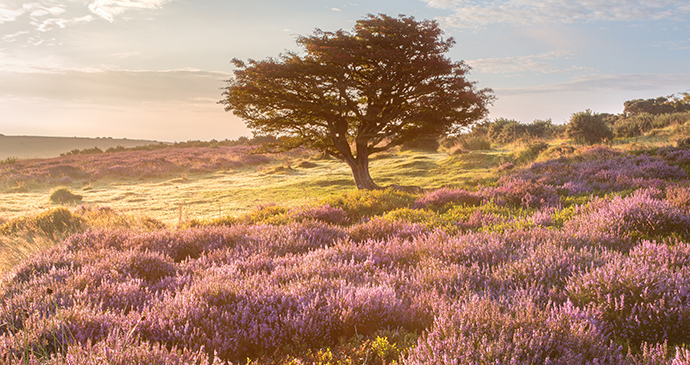
Of all the experiences I have encountered in this region, one stands out because it epitomises Exmoor. I had left scant time to do a newly discovered walk which I’d identified on the map as looking ideal in its combination of moor and coast, with one of my favourite churches, Trentishoe, thrown in and the hospitable Hunter’s Inn providing a base. It also looked short. It was a late September evening and I disregarded all my own advice, setting out without my hiking pole and boots. Which meant that I had to go slowly or risk an accident.
No problem – I needed to spend time enjoying the smell of bracken, the sunlight on the heather, and the sight of the Mediterranean-blue sea below sheer indented cliffs. And to stop to look at birds and views through my binoculars. I walked back to my car through an ancient bit of woodland proclaimed by the National Trust to be a ‘butterfly trail’, though it was now too late to observe insect life. Indeed, it was starting to get dark and I was due to meet friends at a time already past. And, this being Exmoor, there was, of course, no mobile-phone coverage. I asked the barmaid at the busy Hunter’s Inn if I could use their landline. No problem, no charge, just friendly helpfulness.
That’s Exmoor for you.
Food and drink in Exmoor
Exmoor produces some of the best food you can find anywhere. The harsh, hilly environment lends itself to extensive livestock production. Cattle and sheep are allowed to graze over large areas and mature slowly, as nature intended. And on the more fertile soils a surprising variety of food and drink are produced.
By eating food farmed in the region you are literally eating Exmoor – hence Eat Exmoor, an award-winning 2018 initiative to bring together ‘field to fork’ people, from farmers to shops that sell local produce and restaurants that source their food and drink locally. These include blueberry growers, oyster farmers and even a marshmallow maker. Arable farming is a challenge on Exmoor, so organic farms such as Hindon are relatively rare because of the typically infertile soils and short growing season.
A comprehensive website for Exmoor’s food producers is edibleexmoor.co.uk. The region also has its food festivals, the main one being Exmoor Food Festival held each February, when you can find special food deals throughout the area. Lynton and Lynmouth also have their Lyn Food Festival every September, with lots of local stands.
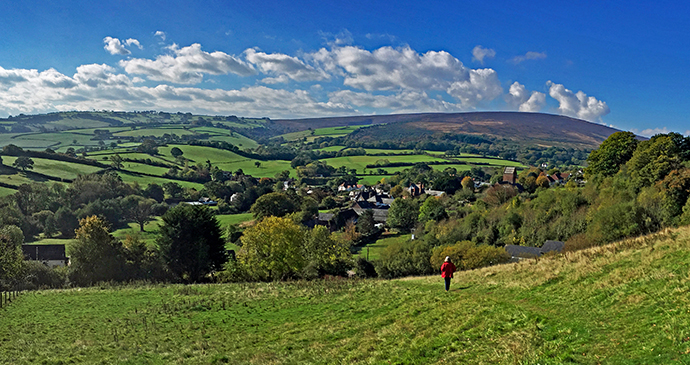
Dairy treats
The taste of Exmoor is undoubtedly that of clotted cream. A cream tea is as integral a part of a visit to this region as rain (indeed, the one often leads to the other).
Clotted cream is quite unlike any other sort of cream, being as thick as butter and almost as yellow; it contains more fat (around 63%, while double cream is 48%), and traditionally was made by gradually heating fresh milk using steam or hot water, and allowing it to cool very slowly. The thick cream that rises to the top was then skimmed off.
The original term was clouted cream, clout being the word for patch, referring to the thick crust that forms when the cream is heated.
Clotted cream is only made in Devon and Cornwall, and we Devonians are not only convinced that ours is better but that we got there first. After all, it was one of the wives of the Dartmoor giant, Blunderbus, who won her husband’s affection by bringing the knowledge of clotted-cream-making to his kitchen. The story is slightly spoiled by the fact that Jennie was exiled to a cave in Cornwall at the time for being a lousy cook, and it was a Phoenician sea captain who taught her the process as a reward for saving his ship from wreckers.
Clotted cream is served with fresh scones, which should be warm from the oven not the microwave; purists prefer plain scones but others, myself included, love the fruit ones. In Devon we spread the cream on the scone first, instead of butter, and add jam on top; in Cornwall it’s the opposite: jam first, then clotted cream. Either way it’s utterly delicious – and very filling. The Victorian prime minister William Gladstone was right when he called clotted cream ‘the food of the gods’.
Talking of jam, an Exmoor speciality is whortleberry jam. Whortleberry is the Exmoor name for bilberry, a heather relative which grows on the moor.
As you would expect by the seaside, there is a proliferation of ice cream parlours and locally made ice cream. One producer in particular stands out: Liscombe Ice Cream, where you can watch cows being milked by robot while enjoying your cone.
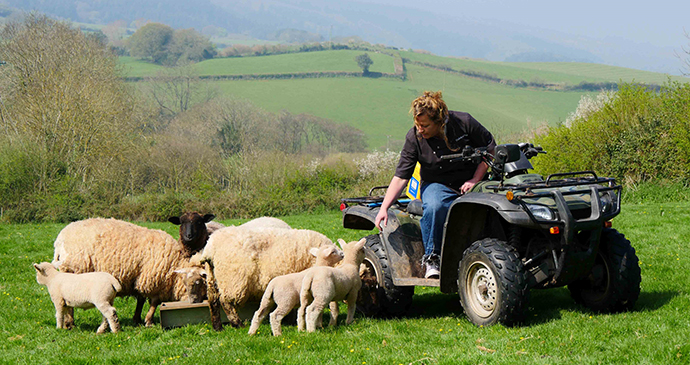
Meat
Meat eaters are in for a treat here. Some hotels convert to shooting lodges in the winter so pheasant, partridge, woodcock and venison feature on many country menus.
The native cattle could claim to produce the best steak in England. The nickname for the north Devon breed of cattle, Red Ruby, is appropriate: these animals are a beautiful chestnut red, the colour of a ripe conker. They are prized for their docility, hardiness and ability to convert grass to succulent, marbled meat. Most of the herds you will see grazing in the Exmoor fields are grown slowly, outdoors (though the climate is such that they need to be brought inside during the winter), with the calves staying with their mothers until they are weaned.
Another native breed, Exmoor horn sheep, has adapted to the conditions here over the centuries. And Exmoor has adapted to the sheep, so the landscape you enjoy today owes as much to the grazing of these animals as it does to nature. The sheep are all-white and, as the name suggests, both rams and ewes have horns. They are dual-purpose animals, raised for wool as well as meat – in the days when mutton was regularly eaten they were considered to have the finest meat of any breed. Devon closewool sheep are another breed from Exmoor favoured for meat and hardiness.
Booze
If clotted cream is Devon, then cider is Somerset although western Somerset is not in the heart of cider country. For this you need to go east to flatter areas where the cider-apple orchards grow, though small cider producers flourish in our region.
Secret Orchard Cider produces award-winning ciders including Exmoor Clear and Exmoor Mellow, as well as the slightly stronger Exmoor Rabbit.
Exmoor also has some small breweries, including Fat Belly in Lynton and Madrigal in Lynmouth, and you’ll find these ales in most farm shops and stores selling local products.
The largest brewery is Exmoor Ales in Wiveliscombe. Their best-known cask ales are Exmoor Gold and Exmoor Beast but they do a total of ten, some permanent and some seasonal.
Also in Wiveliscombe is Cotleigh, whose beers are named after predatory birds: Tawny Owl, Golden Seahawk and Buzzard. They also do seasonal brews such as Rednose Reinbeer.
What to see and do in Exmoor National Park
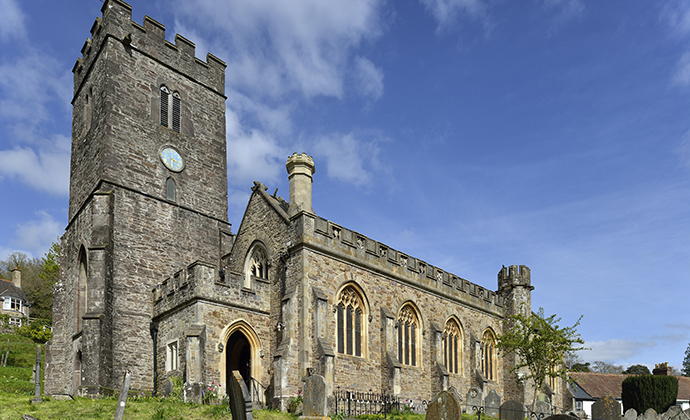
Dulverton
Dulverton seems to have everything going for it: lovely surroundings, plenty to see and do, yet manages to avoid any suggeston of being a tourist hotspot. No wonder the national park chose to have its headquarters here.
Like so many places in Exmoor, Dulverton has its Lorna Doone association and there’s a small statue of the young woman outside Exmoor House. It’s actually of Lady Lorna Dugal ‘who, in the seventeenth century, was kidnapped in childhood by the outlaw Doones of Badgworthy’, so was probably the inspiration for the novel. The hero of the story, John Rudd (known as Jan when he was a boy) first sets eyes on Lorna as a little girl ‘dark-haired and very wonderful, with a wealthy softness on her’ as she sits in a handsome coach near Dulverton. Later, near Dunkery Beacon, he unknowingly sees her again, carried across the saddle of one of the Doone brigands, back to their hideout.
The town’s attractions include a 17th-century bridge over the River Barle, a variety of independent shops, some good restaurants and the excellent Heritage Centre. Shops include the greengrocer H&M (1 Fore St) with a colourful display of all manner of fruit and vegetables, and a farm shop opposite the Bridge Inn that sells fresh produce and snacks.
Art lovers old and young, or anyone searching for quality crafts, should take a look at Number Seven, which, as well as its cards, books and arty items, hosts the outstanding illustrator Jackie Morris and other artists. I particularly liked the ‘textile taxidermy’ by Helly Powell.
Also not to be missed is Tantivy, a super delicatessen and general store with a large selection of local beers and ciders, and a good range of maps and books as well as picnic supplies – so you’ll be all set to head for the moor. But not before you’ve visited The Guildhall Heritage and Arts Centre. Admission is free but donations are appreciated.
There are fixed and shifting exhibits here with lots of variety and surprises, like Granny Baker’s Kitchen where, at the touch of a button, the good lady will chat to you about her life and times. The red deer exhibit tells you everything you need to know about Exmoor’s iconic animal. In a separate building is a model railway, beautifully made and correct to the last detail. It’s Dulverton as it was before the railway was closed, and the little trains purr their way through tunnels and the familiar landscape before drawing to a halt at the station.
Each year Dulverton celebrates a Sunday festival, Dulverton by Starlight, in early December; the town is decorated, the shops stay open, there’s an evening fireworks display from the church tower, and other events are held to help get people into the Christmas spirit.
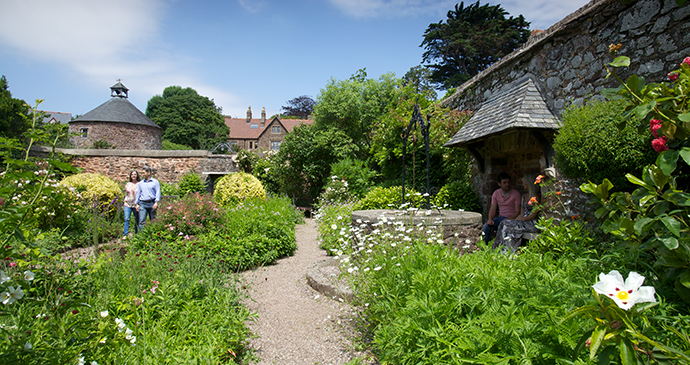
Dunster
Dunster sits just within the national park, and is deservedly the most visited small town in eastern Exmoor. It’s also one of the best-preserved medieval villages in England, with car-harassing narrow streets and the backdrop of a splendid castle and the folly-topped mound of Conygar Wood. Until 2011 the pavements comprised ancient cobblestones that looked lovely but made for painful and sometimes dangerous walking. Parts have now been replaced by paving slabs, which are less charming but easier on the feet.
The shops are tasteful, selling high-quality goods; the traffic is controlled; and there are lots of quality pubs, tea shops and snack bars. Among the shops is the excellent Deli, which sells a good selection of local crafts and a huge range of local beers and ciders.
It’s strange to think that in the 12th century Dunster Haven was a busy port. When the shore became land, the town switched its activities to the wool trade so successfully that the local cloth was known as ‘Dunsters’. The octagonal Yarn Market was built in 1609 to protect the wool traders from the Exmoor weather; it serves a similar purpose for damp tourists today.
Medieval towns like this often feel claustrophobic, but Dunster revels in open spaces and enclosed public gardens. Across one such space, the Village Garden, is the dovecot, which probably dates from the 14th century and still has the nest holes. It originally belonged to the priory but after the Dissolution of the Monasteries was sold to the Luttrells (the family that lived at Dunster Castle for 18 generations). Young pigeon, squab, was a luxury food, and until the 17th century only lords of the manor and parish priests were allowed to keep pigeons.
Near the dovecote is a lovely little church garden, and the red sandstone church of St George. First impressions are of a gloriously intricate wagon roof, some good bosses, and a font with a complicated cover. And the famous screen. Now, most old churches have screens, and many have screens as beautifully carved as this one, with fan vaulting to support the weight of the rood. But none, anywhere, has a screen this length, stretching across the full 54-foot width of the church.
A rural lane running alongside a stream leads to the Water Mill. Dating from the 17th century and grinding wheat daily to produce flour for its shop and local bakeries, it’s an interesting place to visit and the tea room serves very tasty light meals. Continue past the mill and you enter the spacious gardens of Dunster Castle.
This is the perfect approach to the castle: peaceful and uncrowded with, when I was there, only the sound of birdsong and the river. A path winds round to the main, steep entrance to the castle, which is also easily accessed from both West and High streets. Be warned, though; it is a very steep climb (Angina Hill, they call it) from the town or the castle car park so it’s not really suitable for visitors with health problems.
Combe Martin
Squeezed into the crease between two hillsides, within an Area of Outstanding Natural Beauty, this straggly but well-kept town once claimed to have the longest High Street in England. This has now been modified to the longest street party in England, and perhaps the largest number of name changes in one street: five. Once over 70 shops and 19 pubs lined this road; now there are only a handful.
In the early 19th century Combe Martin was noted by writers, and not just the Poet Laureate Robert Southey, as being run down. Charles Kingsley called it a ‘mile-long manstye’. There was a reason, however – landlords deliberately let houses deteriorate to avoid contributing to the Poor Law rates. Inhabitants at that time were called Shammickites, a shammick being a term for a slum.
Nowadays there’s plenty to admire here. The town has a long and interesting history. The Martin part of the name comes from Sieur Martin de Turon, who was granted the lands by William the Conqueror. Legend has it that the last Martin failed to come back from a hunting trip so his father, assuming the lad was staying the night elsewhere, ordered that the drawbridge over the moat be raised.
The unfortunate hunter returned in the dark, fell into the moat and was drowned, thus ending the Martin line. His father was so consumed with grief and guilt that he left Combe Martin forever.
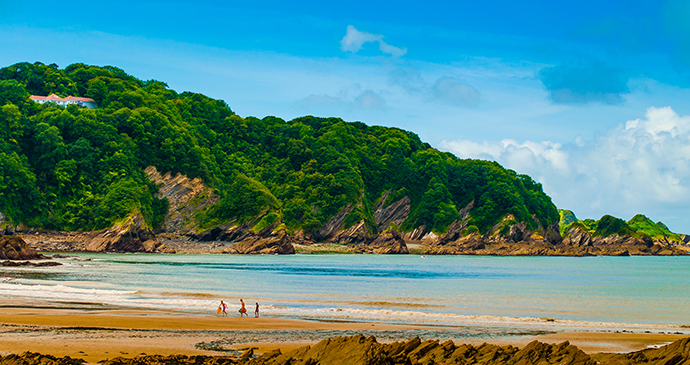
The family seat passed to the Leys, a descendant of whom built the town’s most extraordinary building: the Pack o’ Cards, a piece of 18th-century eccentricity created by George Ley, a gambler, in homage to his success. All its numbers echo those in a pack of cards, hence its four floors (suits), 13 doors and 13 fireplaces (cards in a suit), and originally 52 windows (cards in a pack); also the whole thing looks like a house of cards. Ley, who died in 1709, has a memorial in the church of St Peter ad Vincula (St Peter in Chains).
Its 100-foot-high tower has been dated at 1490, and was probably built by the same stonemason as neighbouring Berrynarbor and Hartland. A local jingle describes these towers: ‘Hartland [in northwest Devon] for length, Berrynarbor for strength, and Combe Martin for beauty.’ It is indeed a decorative tower, with statues set in niches. Inside are all sorts of treasures.
The rood screen, which dates from the 16th century, has been expertly cleaned to bring out the colours and details of the painted saints in the panels. There are some carved bench ends and more recent poppyheads (three-dimensional wood carvings) in the choir including a Combe Martin fisherman and a whale. Carved on the capitals above the pillars are the usual vine leaves and grapes, but look out for the rare green woman. On the wall, but too high up to see the detail, is a highly regarded marble sculpture of Judith Ivatt, wearing an exquisitely carved lace collar.
The town has more than its share of festivals. A lively carnival is held during the second week of August, when a giant ‘grey mare’, ridden by Old Uncle Tom Cobley and All, parades around the town on Wednesday evening, presumably looking for Widecombe Fair. There’s also a Strawberry Fayre in June, celebrating the town’s history as a major fruit-growing region, and the bizarre but hugely enjoyable Hunting the Earl of Rone, which takes place on the Spring Bank Holiday. ‘They like dressing up in Combe Martin,’ the lady in the tourist office told me. Indeed!
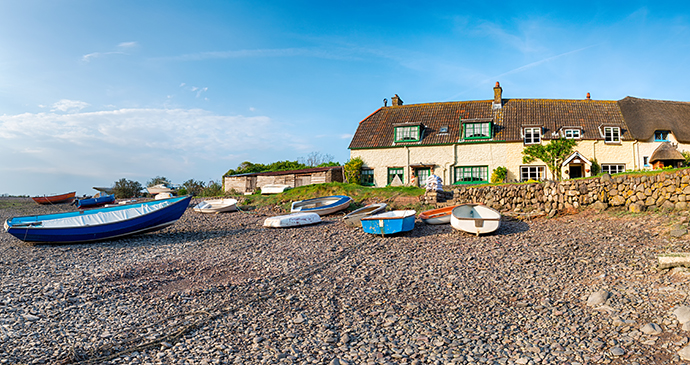
Porlock Weir
The sea left Porlock’s working harbour high and dry back in the Middle Ages, but at neighbouring Porlock Weir the shingle bar protected a tidal inlet and kept the harbour open – as it has been now for at least a thousand years. In the 18th and 19th centuries, Porlock Weir was a busy little port, for coasters carrying timber across to South Wales and returning with coal.
There was also an oyster fleet, and these delicacies are once again being farmed here. Today yachts come and go from its sheltered marina and fishing boats bring in their catch. The row of thatched cottages next to the harbour provides a strand of brightness between the grey expanse of shingle and the dark woods above.
The village has a large car park with toilets for walkers. Facing the harbour is a variety of places to eat, including the Harbour Gallery and Café, which combines homemade cakes, good coffee, ceramics and paintings; and Ziangs for Asian street food.
A little maritime museum displays old photos and relics, including details of the lifeboat Louisa’s heroic rescue in 1899; next door is Exmoor Glass, where you can browse a huge selection of stained-glass objects. Exmoor Adventures offers kayaking, stand-up paddle boarding and other water activities.
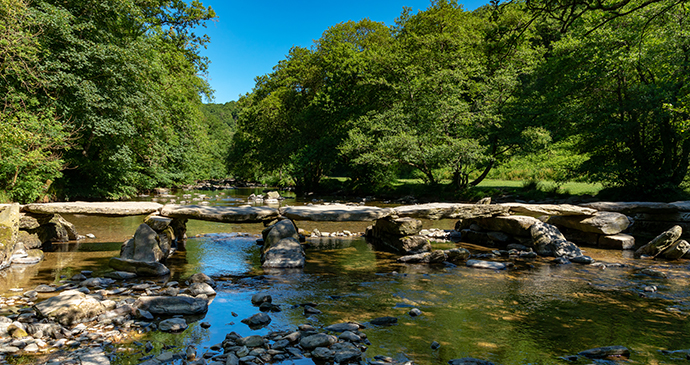
Tarr Steps
Perhaps Exmoor’s best-known inland attraction, this is a beautifully preserved clapper bridge over the River Barle. Some say it’s over a thousand years old but it’s more likely to date from the 13th century. Either way, the feat of building it out of giant slabs of stone, which were brought in from a considerable distance, is remarkable. Some slabs are over six feet long and weigh more than a ton. Despite their size they are periodically washed away after heavy rain swells the river. All have been numbered so they can be reassembled correctly.
There’s a spacious car park some way above the river, but there’s disabled parking near the bridge, next to Tarr Farm with its irresistible teas and walkers’ menu. Tarr Steps is perfect for a family picnic, though it can get very crowded in the summer. Children and dogs love the paddling, and there are several deep pools where you can get fully immersed if you wish.
Be cautious about sunbathing on the stones, however – that’s the Devil’s prerogative. Legend has it that he built the bridge, so was understandably peeved when mere mortals tried to use it.
The locals asked the vicar to help; he prudently sent a cat across first to test the waters, so to speak, but it disappeared in a puff of smoke. Undaunted, the reverend set out himself and after a heated argument the Devil agreed to let people use the bridge. Except when he wants to sunbathe.
For the energetic there’s a pleasant eight-mile walk along the right-hand (eastern) bank of the river to Withypool, where you can enjoy a snack before picking up the Two Moors Way back towards Tarr Steps, turning left towards the river at the T-junction at Parsonage Farm. This, and the walk to Dulverton, are shown on the Croydecycle map Dulverton & Tarr Steps.
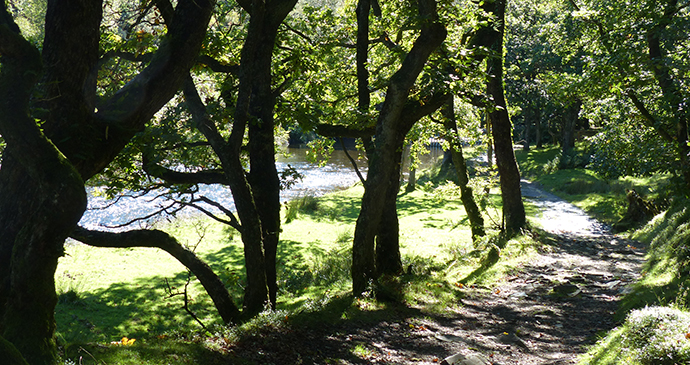
The Doone Valley
From Watersmeet the lovely East Lyn River draws you towards Brendon and on into Somerset where it becomes Oare Water. This is a seductive region of tea shops, pubs, medieval bridges – and Lorna Doone.
Further along the road or path from Rockford is Brendon, another small village with a welcoming pub, the Staghunter’s Inn, highly praised for its excellent food, atmosphere, and as a base for walkers. From here an inviting path runs along the bottom of a steep escarpment into Somerset and then back along the top to Brendon.
You are now in Lorna Doone country. In Malmsmead, at the Lorna Doone Inn (01598 741450) if you sit outside, your cream tea will be shared by bold wild birds. Near the packhorse bridge over Badgworthy Water, which marks the boundary with Somerset, is Lorna Doone Farm. A walk to the legendary Doone hideout starts from here.
Park in the long-stay car park and walk back to the village and up the hill straight ahead to the start of the bridleway on your left, signposted Badgworthy Valley. Follow this track and then a grassy path next to the wire fence. Drop down to the river and the little footbridge to Cloud Farm Tea Room and Oare.
For the Doone Valley, keep the river on your left. With its deep pools and fast-flowing sections it fits the description in the book where the boy John Rudd went fishing for loach. Soon after the Cloud Farm footbridge you’ll come to the Blackmore Memorial Stone on your right, erected for the centenary of the book’s publication. Passing through a gate into Badgworthy Wood, you cross over Yealscombe Water, and come to the loveliest part of the walk with fern and moss-covered oak trees flanking the river.
Shortly before the Lankcombe Water footbridge the path forks. Ignore the right-hand fork and continue beside the river and over the footbridge, through woods as the path gently rises to meet open moor. This is the site of the medieval village – you can see the remains of stone walls – and the legendary Doone Glen.
Related books
For more information, see our guide to Exmoor National Park:
Related articles
Leave the car behind and explore Britain’s highways, byways and coastal pathways on two wheels.
Look at the stars, look how they shine for you.
Whether you are looking for a bench with a view or a grassy meadow with a stream, you can find it on Exmoor.
